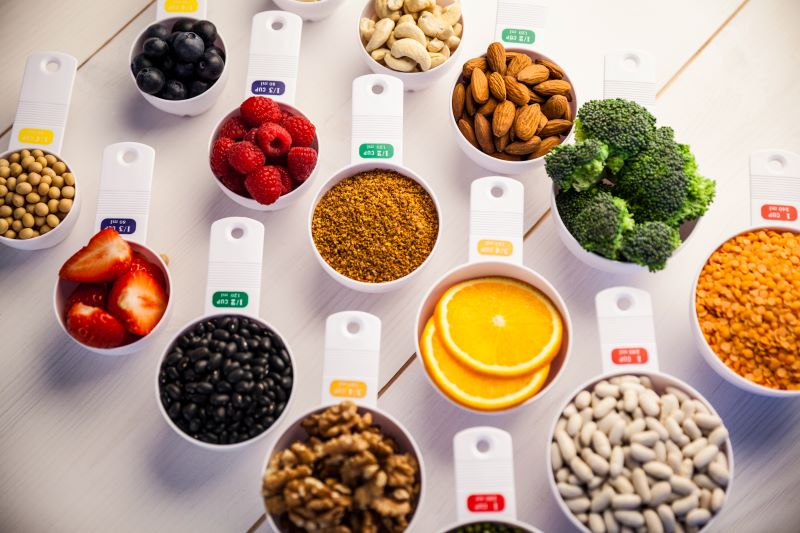What are Phytonutrients, its Types & Common Food Sources

Our body uses food as a source of energy, and phytonutrients, also known as phytochemicals, are necessary for this process. Phytonutrients are plant substances that can improve the quality of health or enhance health conditions and life spans. Many researchers have demonstrated their significance in curing or preventing different diseases.

Table of Content

What are Phytonutrients?
In simple words, phytonutrients are organic substances synthesised by plants to prevent insect attacks in their search for self-protection. Hence, they support one’s overall health through powerful antioxidant functions and other anti-inflammatory benefits.
Phytonutrients are wonderful for improving your immune system, fighting disease, and balancing hormones. However, there are numerous types of phytonutrients, some of which are still untested. Known compounds facilitated by them can cure even chronic diseases such as diabetes mellitus, cancer and cardiac complications.
Types of Phytonutrients
Understanding how natural compounds are distributed based on their chemical structures is challenging for some individuals. Therefore, below is a brief description of various types of phytonutrients:
Types |
Description |
| Flavonoids | Vitamin P, alias flavonoids, are plant-related nutrients. They have anti-inflammatory properties and can arrest tumour growth. They also raise the synthesis of concatenating enzymes, aiding the body's detoxification process. |
| Tannins | Walnuts, pomegranates, raspberries, strawberries, grapes, and ellagic acid are among the foods that contain tannins. They possess anti-inflammatory, anti-cancer, and antioxidant qualities, all of which can aid in quickening the clotting process and lowering blood pressure and plaque buildup in the arteries. |
| Carotenoids | Fruits and vegetables get their colours from carotenoids, a plant pigment. These carotenoids can exceed in abundant fats and support their immune systems and ocular well-being due to their antioxidants. Additionally, it can be easily changed into vitamin A, which helps improve eyesight and prevent cancer. |
| Resveratrol | Grapes have it mostly and help keep the cardiovascular system and mental health in check. In a real sense, some found that once they increased resveratrol intake, their cerebral blood flow increased. |
| Ellagic Acid | Ellagic acid is one popular phytochemical for lowering cholesterol and cancer risks. Besides having anti-inflammatory and antioxidant characteristics, it is also rich in raspberries. |
| Glucosinolates | When it comes to controlling inflammation, metabolism, and stress, the best bet is glucosinolates, found mainly in cruciferous vegetables and are thus easily reachable. |
| Phytoestrogens | Phytoestrogens are compounds that mimic estrogens and thus help women relieve the discomfort that is associated with hot flashes and other symptoms that accompany menopause. Furthermore, these substances help prevent severe diseases such as cancer, heart disease, and osteoporosis, among others. |
| Curcumin | Its typical yellow colour comes from the most important ingredient of turmeric, curcumin. Due to this element, turmeric has anti-inflammatory, anti-oxidative, anticancer and anti-thrombotic features. It also protects the heart. It may help detoxify harmful agents, making our fight against tumours more feasible. |
| Capsaicin | The soluble compound capsaicin, related to the alkaloid family, gives bell peppers and chillies their heat. Eating capsaicin may release endorphins, which are happy-making hormones. Capsaicin also reduces inflammation and inflammatory conditions. |
| Carotenoids | The main carotenoids are alpha-carotene, beta-carotene, beta-cryptoxanthin, lutein, zeaxanthin, and lycopene. They often improve the immune system's function, help cells communicate with each other, protect from heart disease or cancer, maintain eye health, etc. |
| Anthocyanidins | Their presence causes plants to have yellow, orange, and red colours. Alpha-, beta-, lutein, zeaxanthin, beta-cryptoxanthin, and lycopene make up the core carotenoids, which often help retain good ocular health, boost the immune system, and prevent cancers and heart diseases. |
Common Food Sources of Phytonutrients
Supplements that contain this organic plant ingredient are available today! On the other hand, some people would choose to take this substance through foods rich in various nutrients. Consequently, these examples of phytonutrients can be incorporated into your meals:
Dark green leafy vegetables like romaine lettuce, broccoli, spinach or kale are great sources of phytonutrients and are easily available.
Fruits like peaches, mangoes, sweet potatoes, berries and other red, orange and yellow-hued fruits contain many phytonutrients.
Whole-food products like barley bread, quinoa pasta, brown rice porridge, wheat, wild rice and whole-grain cereals are also abundant in phytonutrients.
Food items like leeks, garlic, onions, and chives are served alongside coffee and tea. Rather, black tea and green tea, among other herbal teas, are preferable.
Legumes are food items like beans, peas, soya beans and lentils. Also, dark chocolate is rich in phytonutrients.
Phytonutrient Rich Food Items to Include in Your Diet Plan
Meal of the Day |
Food Items to Include in the Diet Plan |
| Breakfast | Oats or cereal with nuts, chia seeds, avocado, quinoa, tofu, and dried fruits. |
| Lunch | Leafy salad with almonds, yellow vegetables, sweet potatoes and orange fruit. |
| Snack | Bananas, oranges, nuts, berries, dark chocolate, and coffee. |
| Dinner | Any legume curry with a whole-grain tortilla and eggs. |
| Dessert | Ice cream or milkshakes. |
Useful Tools to Track Your Health
Health Benefits of Phytonutrients
Similar to how vitamins and minerals are necessary for the body to operate properly, phytonutrients have a variety of applications. The body requires the molecule to keep itself healthy and avoid illness.
The following are some advantages that phytonutrients provide for our body:
- Rich in Antioxidant Properties: Phytonutrients are usually termed “body scavengers” due to their high antioxidant level. They naturally prevent destruction from free radicals, highly reactive and unstable molecules caused by toxic conditions.
- Enhancer of Immunity: Certain phytonutrients in the body assist the immune system to function properly. They also reduce the probability that harmful germs and viruses will multiply inside the body and reduce the harm if caused.
- Anti-Inflammatory Effects: One key advantage of phytonutrients is their ability to minimise inflammation. Maintaining this state helps prevent heart disease and worsening diabetes.
- Prevents Cancer: Phytochemicals promote apoptosis and delay tumour progression. Research has shown that this natural product is indispensable for the treatment of melanoma and nonmelanoma skin cancer.
- Diminishes Anti-Aging Effects: Phytochemicals further aid the natural anti-ageing process within the body. The most common ones for this purpose include curcumin, quercetin, epicatechin, resveratrol, and allicin.
- Neuroprotective Properties: According to recent studies, phytochemicals are powerful neuroprotective agents. This way, they have been of use when medication for diseases like Parkinson's and Alzheimer's is being conducted.
Using the above information, one can estimate the number of phytonutrients the body needs. Therefore, it must be included in people's diets, ideally fruits and vegetables.
Risk of Overconsumption of Phytonutrients
Phytonutrients found in various plant-based foods such as fruits, vegetables, legumes and whole grains, among others, are also generally accepted to provide many health benefits.
At present, scientists have yet to have full definitions concerning many phytonutrient aspects because they are very complex. Most phytonutrients have unknown long-term effects, side effects, and toxicities arising from excessive use.
Some materials, like phytoestrogen, can cause problems if used in excess or disproportionate amounts. Take them in the amount provided by a doctor while eating them, for they are well presented to man by nature.
Supplements may need to be revised to work to the optimum level. It is solely because the phytonutrients from natural sources like fruits and vegetables are more effective.
The market for dietary supplements is not properly regulated, which means there is a possibility you may develop an allergy or suffer from symptoms such as diarrhoea, acne or even kidney failure.
Harmful Effects of Phytonutrients
Fruits, vegetables, and other plant-based meals include compounds called phytonutrients. However, just like anything else, phytonutrients can have negative effects if taken excessively or under specific conditions. The following are some possible negative consequences of phytonutrients:
- Reactions Triggered by Allergies: Humans exposed to certain phytonutrients could react allergically. Such antinutrients occur in specific plant varieties which interact poorly with some people’s immune systems.
- Toxicity: Excess consumption of specific plant phytonutrients results in toxicity. For instance, eating green potatoes could lead to high levels of poisoning caused by solanine, while ackee is also dangerous.
- Oxalate toxicity: Some foods with a lot of oxalic acid, like spinach, rhubarb and beet greens, may cause kidney stones to develop among those likely to form it. Oxalic acid binds with calcium in the human organism, thus producing kidney stones.
- Goitrogens: Cruciferous vegetables may contain phytonutrients called goitrogens, which suppress iodine uptake and decrease hormone synthesis. When eaten excessively, they may induce alterations of this gland, mainly marked by low iodine levels.
Phytonutrients usually have a beneficial effect on health when taken as part of a well-rounded eating plan. However, individuals with allergies, intolerances, or specific health conditions must be cautious and seek personalised advice from a medical professional or dietitian if necessary.
Phytonutrients' antioxidant, anti-inflammatory and immune-boosting properties are key to maintaining well-being and health. They are mainly found in fruits, vegetables, legumes, and whole grains. Incorporating various phytonutrient-rich foods into a balanced diet is key to reaping their health benefits while minimising risks.
Protect What Matters - Explore Other Insurance Options














